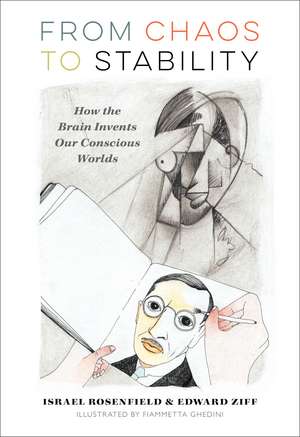From Chaos to Stability: How the Brain Invents Our Conscious Worlds: The New Neuroscience
Autor Israel Rosenfield, Edward Ziff Ilustrat de Fiammetta Ghedinien Limba Engleză Paperback – 17 sep 2024 – vârsta ani
To make sense of this chaos, the brain must simplify the sensory inputs by creating, or inventing, the colors, sounds, smells, forms, and faces that are perceived in consciousness, which become a proxy for the chaotic world in which we live. The brain’s ability to generalize and categorize these invented perceptions, and to relate them to one another, enables it to form memories, which are not fixed representations of things past, but a dynamic and malleable function of the brain that is relational.
When formation of these worlds breaks down, neurological differences arise. Although the mechanisms that transform sensory chaos into the simplified perceptions experienced in consciousness remain elusive, Rosenfield and Ziff relate what they have learned by means of imaging brain activity and by mapping the neural circuits that comprise memory traces. In addition, the authors offer perspectives for future studies of consciousness.
Preț: 100.44 lei
Nou
Puncte Express: 151
Preț estimativ în valută:
19.22€ • 20.12$ • 15.90£
19.22€ • 20.12$ • 15.90£
Carte disponibilă
Livrare economică 15-29 martie
Preluare comenzi: 021 569.72.76
Specificații
ISBN-13: 9781609389895
ISBN-10: 1609389891
Pagini: 142
Ilustrații: 27 color illustrations
Dimensiuni: 140 x 203 x 13 mm
Greutate: 0.23 kg
Editura: University of Iowa Press
Colecția University Of Iowa Press
Seria The New Neuroscience
ISBN-10: 1609389891
Pagini: 142
Ilustrații: 27 color illustrations
Dimensiuni: 140 x 203 x 13 mm
Greutate: 0.23 kg
Editura: University of Iowa Press
Colecția University Of Iowa Press
Seria The New Neuroscience
Recenzii
“How do we make sense of the ‘blooming, buzzing confusion’ that exists in the world around us—the sight of trees, the sounds of birds, and the smell of our grandmother’s kitchen—and even store memories of those things? And what are the consequences when those processes breakdown? In From Chaos to Stability, Rosenfield and Ziff wonderfully work through the argument that sensory perception and memory is a creative, personalized, generative process of the brain to simplify and make sense of a complicated world. If a tree falls in the forest and no one is there, does it make a sound? No, argue the authors. Sounds, and other sensory perceptions, are the creation of the brain in the attempt to make sense of the different, dynamic forms of energy and matter with which we are surrounded. Some, but not all, of those experiences reach our consciousness and allow us to experience our lives within what appears to be a stable temporal and spatial flow. The book is written for a lay audience and sets the arguments within a rich overview of the history of these fundamental questions. For those wanting a more detailed understanding of some of the underlying science, there is an outstanding appendix that gives a brief background on the neuroscientific basis of the book’s main points. A very enjoyable read, including rich historical references and case studies on how the brain helps create our experienced lives and what happens when it fails to do so.”—Donald A. Wilson, coauthor, Learning to Smell: Olfactory Perception from Neurobiology to Behavior
Notă biografică
Israel Rosenfield taught at the City University of New York. His books include Freud’sMegalomania, a New York Times Notable Book of the Year. He was a Guggenheim Fellow and a longtime contributor to the New York Review of Books. Edward Ziff is professor emeritus of biochemistry and molecular pharmacology at New York University Grossman School of Medicine. Among others, he is coauthor of DNA for Beginners. Ziff divides his time between New York City and the Catskill Mountains. Fiammetta Ghedini received a PhD in Innovative Technology from Scuola Superiore Sant’Anna (Pisa) and UCL (London). She combines her scientific background with a life-long passion for drawing by producing comics and illustrations. She wrote and comanages ERCcOMICS.
Descriere
At the heart of Israel Rosenfield and Edward Ziff ’s inquiry is the nature of brain function. The brain must simplify various sensory inputs by creating, or inventing, colors, sounds, smells, forms, and faces that are perceived in consciousness, which become a proxy for the chaotic world in which we live. The brain’s ability to generalize and categorize these invented perceptions, and to relate them to one another, enables it to form memories, which are not fixed representations of things past, but a dynamic and malleable function of the brain that is relational. Written for a lay audience, Rosenfield and Ziff relate what they have learned by means of imaging brain activity and by mapping the neural circuits that comprise memory traces.
